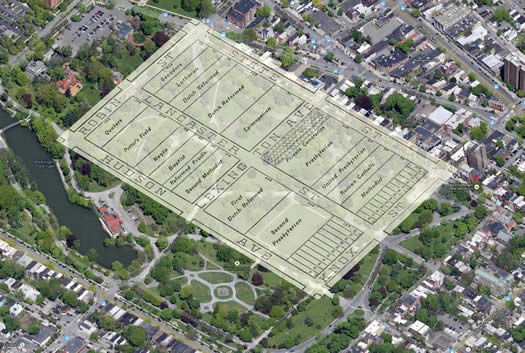Washington Park's former life

Historical fact of the day, because Halloween: The site of what is now Albany's Washington Park was once a cemetery -- a rather large cemetery.
The image above was created by Albany Archives. It's an overlay of a map of the old cemetery on Washington Park. It covered a big portion of what's now the park.
A few years back Paula Lemire wrote about the "State Street Burying Grounds" over at Albany History. A clip:
The State Street Burying Ground, founded in 1800 as an alternative to the overcrowded churchyards and private family graveyards, was located at the present park's northeast corner. Enclosed by a ten-foot high wooden fence, the grounds were divided into four large section for various churches, as well as an area set aside for strangers, African-Americans, and deceased persons not associated with any religious congregations. Graves from a number of smaller burial grounds were relocated here as progress encroached on downtown churchyards, raising the real estate value of land previously dedicated to the dead.
Within a few decades, however, the State Street Burying Ground was already in serious decline. The high mortality rate of the early 19th-century, combined with epidemics such as an 1832 cholera outbreak, had resulted in a badly overcrowded graveyard. The fence had suffered from neglect and vandalism, livestock wandered freely among graves, headstones were stolen or damaged, and immigrant gangs used the forlorn spot for violent brawls.
After the opening of the Rural Cemetery in 1844, the State Street Burying Grounds' condition became so pitiful that it was deemed "in the highest decree discreditable to the city authorities and the churches interested." A future Superintendent of Albany's parks later recalled that there was "a mouldy and neglected air about the place."
The situation eventually prompted the Common Council to close the cemetery, and the graves -- said to be 40,000 in number -- were moved to the then-new Albany Rural Cemetery all the way out in the far, far reaches in would come to be called Menands.
Of course, the Albany Rural Cemetery still exists (even if it's no longer rural). And it's a nice place to walk as you take in the monuments to the many Albany-famous figures from the past.
Earlier on AOA: Capital Region haunts
Hi there. Comments have been closed for this item. Still have something to say? Contact us.
Comments
Late at night, if you listen closely, you can hear the ghostly moans of lost souls echoing through the park.
Or it could just be people who had too much to drink who are on their way home.
... said Rob on Oct 27, 2014 at 1:07 PM | link
You know they had to have missed a few...
... said ace on Oct 27, 2014 at 1:47 PM | link
Why do you think the dogs love to run around and dig there??
... said ace on Oct 27, 2014 at 2:02 PM | link
Huh... about those ghostly moans on Washington Park...
... said Joe A on Oct 27, 2014 at 2:41 PM | link
Are you absolutely sure that they moved ALLLLL the bodies? This is Albany and it seems like a lot of the dearly departed continued to vote for years after their demise!
... said Mark on Oct 29, 2014 at 8:03 AM | link
Well, given how frequently remains turned up around the present site of Albany High School and St. Mary's Park many years after the graves there were removed to St. Agnes Cemetery, it would absolutely NOT surprise me if there were quite a few bodies left behind in Washington Park.
The names on the Common Council's list prior to the mass exhumation were compiled from the gravestones and there were likely quite a few graves that were unmarked (in some cases, the headstones may have been stolen or broken) and overlooked; especially in the "strangers" section which was basically a large potters field where all but two or three graves were not marked with headstones.
As it is, not all of the gravestones made it to the Rural Cemetery's. Some were lost in transit. At least one headstone ended up in St. Agnes by mistake and another (along with fragments of two others) ended up behind a house near the Empire State Plaza:
http://www.gardenalley.net/gravestone.html
Earlier this summer, I saw a National Grid crew digging a trench along the State Street side of the park near the old Lutheran and Dutch Reformed sections of the burying grounds and I won't deny a few sneaky glances into the holes on the slim chance there were coffin fragments peeking through the soil.
Also, that total of 40,000 graves doesn't even include those removed privately by families before the Common Council undertook the mass removal.
The idea of removing the old municipal burial ground was brought up in the Common Council almost immediately after the new Rural Cemetery opened in 1844 and some people decided not to wait for the Council to take action or just didn't want their loved ones graves removed as part of a wholesale exhumations. There are quite a few family lots at the Rural Cemetery which contain graves privately transferred from the old burial grounds between 1844 and 1868. In some cases, the original headstones and monuments were transferred to these new plots.
... said Paula Lemire on Oct 29, 2014 at 11:56 AM | link